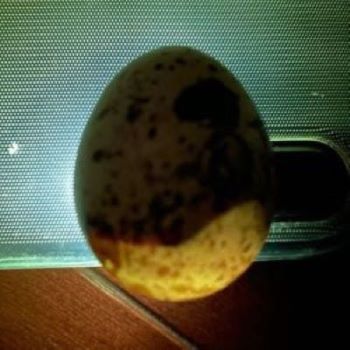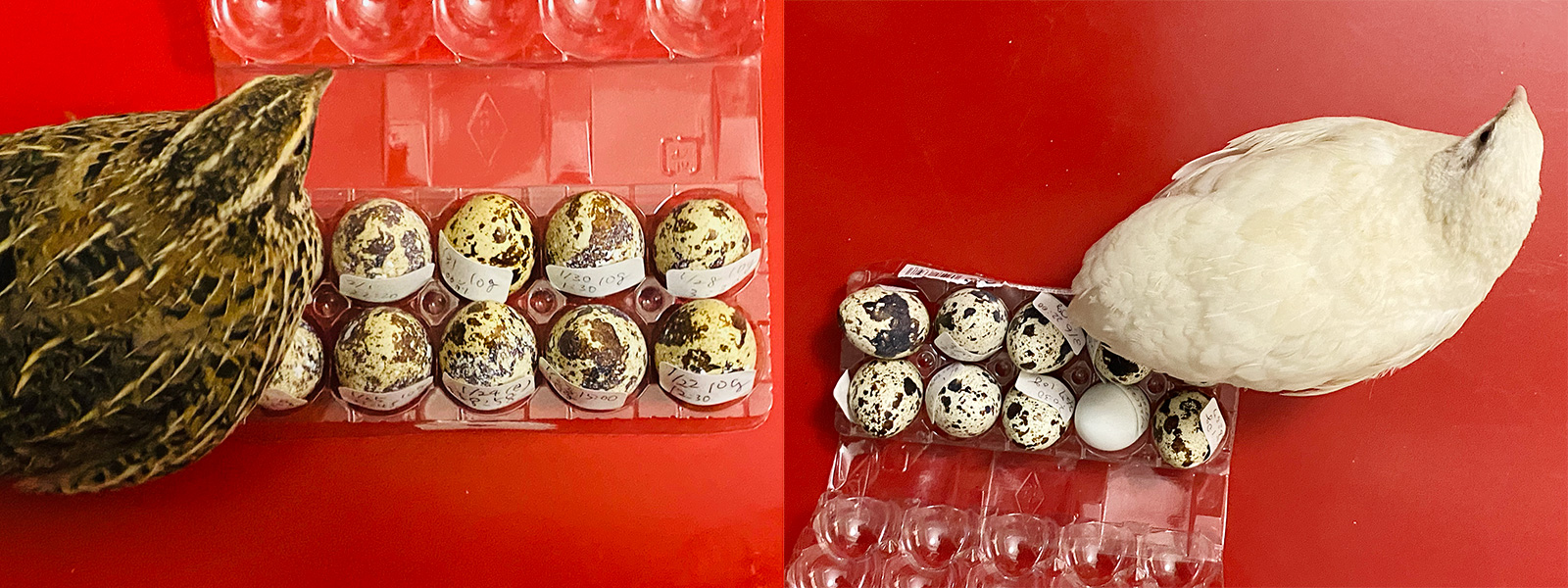The 134th Installment
Living with Quails
by Jun Ito,
Associate Professor
One area of stay-at-home consumption that saw an increase during the COVID-19 was the pet economy. I also started raising pets like many other people. I thought that I would be unable to bear the pain of the passing of a dog or cat that could live with me for more than 10 years, so I decided to give up on the idea of owning a Shiba Inu and to look for a small pet. The first pet I chose was a kind of bird. Perhaps Japanese readers will not be able to read the character for it. To be honest, I do not think I could even read it until now. The bird was a quail. Incidentally, in biology, animal species are usually written using the katakana script in Japanese, but since its name in the hiragana script somewhat resembles how it looks, I will use the hiragana script here (although you cannot see this in English)[n1] .
The scientific name for the Japanese quail is Coturnix japonica, and the Japanese have long been familiar with this bird, with the fifth month of the lunar calendar once referred to as the month of the quail, and quails appearing in waka poetry by Otomo no Yakamochi in the Manyoshu. Wild quails are in the Class II category of endangered species by the Ministry of the Environment's Red List 2020, and were removed from the list of animals that can be legally hunted under the Wildlife Protection and Hunting Management Act in 2013. On the other hand, it is the only animal in Japan that has been domesticated and is legally treated as livestock. Even if you want to keep them only as pets, you must notify the prefectural governor every year in accordance with the Act on Domestic Animal Infectious Diseases Control. It is not a big hassle, though, since all you have to do is fill out one form and mail it in.
It piques most people’s interest when I say I am raising quails. Not many people have ever eaten a quail's egg, and even fewer have ever seen a quail itself. I recommend that shy salespeople should raise quails, as it will be a good conversation starter when meeting new people.
My first encounter with quails was at a pet store in Tokyo, which I visited for research for a pet product project during my previous job (speaking of which, I do not remember any pet products being designed after that, so the project must have been put on ice). The first quail I saw was adorable, and had a feather pattern and form that looked like a wild boar piglet. I remember it was being sold for about 2,000 yen. I was so surprised that is cheap compared to dogs and cats (I later realized that hamsters cost about the same as well).
Do these inexpensive quails actually become attached to people? There would be no sense in going through to raise animals that would not even like me as my first pets. Research has shown that despite individual differences in adult birds, they do become attached if you hatch them from eggs. So I had no choice but to do just that.
I could easily buy fertilized eggs and an incubator when I searched the internet. I put about ten fertilized eggs in the incubator, and kept the temperature at 38 degrees Celsius for 17 days while wondering what would happen after they all hatched. The incubator rolls the eggs little by little, so you do not need to turn them yourself (I did not even know that this was necessary) and basically just need to wait.
Now I just had to wait and see. This was difficult. I wondered if the eggs were growing properly. Shining a light through the eggs lets you visually check the development of the embryos inside. It seems the light from an iPhone is sufficient. After incubating them for a few days, anyone can see what looks like blood vessels and the heartbeats of embryos, but it is difficult to know which eggs are promising. Even so, it is said that if the eggs are shaken or exposed to outside temperatures for a long period of time, this may stop embryonic development.
In the end, I failed to incubate eggs twice. My failures ranged from eggs with no embryonic development at all and just a yolk, to embryos that were almost full quails with feathers all over their bodies but seemed to have run out of energy inside the egg. On the verge of giving up, on the third try, two birds hatched at about the same time. I bought fertilized eggs, but the hatching success rate is around 20%. It was more difficult than it seemed.
Around two days before the eggs were scheduled to hatch, I was surprised to hear occasional chirping coming from the eggs. The chicks have almost finished developing in the egg just before hatching, so they naturally breathe and chirp. Incidentally, there is an air chamber in the larger part of egg (Fig. 1) where chicks breathe. That is why their beaks always come out from this part, which eventually breaks and allow the chicks to emerge. You could say that the Little-Endians of Lilliput in Jonathan Swift's Gulliver's Travels, who believe that boiled eggs should be broken from the little end, were wrong all along.

Fig. 1: Egg with light shown from below about a day before hatching. The black area is the chick, and the area where you can see the light is an air chamber. (Photograph by Jun Ito)
My chicks are about two weeks old and have become adults. Quails can fly because they are migratory birds, but they basically run around on the floor if you let them loose in a room. Sometimes they fly when they get in the mood, but it is extremely rare (and when I wrote this, they flew for the first time in a long while!). They seem to understand the human language somehow, and although they have few facial expressions, you can understand their mood from changes in their cries. In addition, there are considerable individual differences in food preferences and personalities. It is said that they become attached to you if you hand-feed them mealworms, but my quails were happy to grow up eating mainly commercial fishmeal, and they love bean sprouts and white sesame seeds so much that they pounce once I offer it to them. I want to let you know that they can be raised without insects.
Some are used to being petted and lie down next to humans to relax, while others do not like being petted when they approach and run away (even though they soon come back again). They sometimes peck at my hands to play with me, but I am surprised by their obviously intelligent behavior, such as when they momentarily hesitate or peck at the cuffs of my clothes instead of my hands, perhaps because they know that poking at my hands will upset me.
When I actually started raising them, it was different from the information I had gotten in advance. This is in regard to their cries and eggs.
Quail are said to be quite loud. They were liked and raised by samurai families because their cries sounded like the Japanese word for “good omen,” but all mine have done is murmur, maybe because they are females. Just chirps, squawks, and warbles. After laying eggs, they sometimes make louder hissing sounds, but they are generally very quiet and soothing. A very nice surprise indeed.
Quail eggs have spots for camouflage, which are produced by being coated with a pigment secreted in the uterus two to three hours before they are laid*2. This pattern of spots is different for each quail (according to the distribution of cells that produce pigment), and eggs laid by the same mother can be recognized by their similar patterns. There is also research showing that quails know the pattern of their own eggs, and select colors of soil that are best for camouflage*3.
Now take a look at the eggs laid by my quails (Fig. 2). There are quite a wide variety of marks on eggs laid by the same quail, so I feel that it is impossible to tell which one laid what. The white quail in the photo on the right laid a surprisingly perfect white egg, which is perhaps premature and has not been coated.

Fig. 2: Eggs laid by each quail. On the left is the first quail that hatched and its eggs, and on the right is the white quail that hatched next and its eggs. (Photographs by Jun Ito)
Chicken eggs are depicted in picture books as being laid quickly and simply, but my quails walked about restlessly for an hour before laying their eggs, and when they did finally to lay them, their volume (surface area?) swelled up to about 1.5 times the normal size. It seemed like pretty hard work, and the lives of female quails are shorter. After seeing how they lay eggs, I feel sorry that the retail price of an egg is only a little more than 10 yen. The number of Japanese quail farmers exceeded 1,000 at its peak, but due to the COVID-19 pandemic, the number has reduced to just 27. Everyone should eat more quail eggs to help them.
Although cliché, the advantage of having a pet is that you can experience the mystery and preciousness of life. My first chick laid eggs almost every day, but suddenly became weak one day after laying eggs, and passed away without a clear cause despite being taken to a veterinarian the next morning. I never want to experience the pain of having a life fade away in my hands again, but I also understood then that the only thing that can fill the void of pet loss is another pet. Now I have one white quail and one blue sapphire hamster that I recently welcomed into my home.
When I looked up foods that birds should not eat, I found out that avocados are highly poisonous to them. I thought it was odd when I saw my quail standing on one leg, but learned that they pull one leg on their body because they are cold, just like flamingos do since it is cold in the water. I learned many other things about quails in a domino effect, such as Nagoya University, where poultry farming is thriving locally, is conducting extensive research on quails and has already decoded their genome, there is a national treasure called the “Quail” at the Nezu Museum, and the second Japanese character in the word for “paralysis” is actually the character for a female quail. I have two Masters degrees: one in agriculture, and another in animal husbandry. I know a little about chickens, but nothing about quails.
There is now an endless amount of information, but we tend to see only the information that interests us in the end. I do not want to exaggeratedly talk about serendipity, but it is surprisingly difficult to get the chance to try something new from among all the countless things around us, so I think it is a good idea to do so consciously.
So, I hope that all of you start something new and go to graduate school to try learning again.
